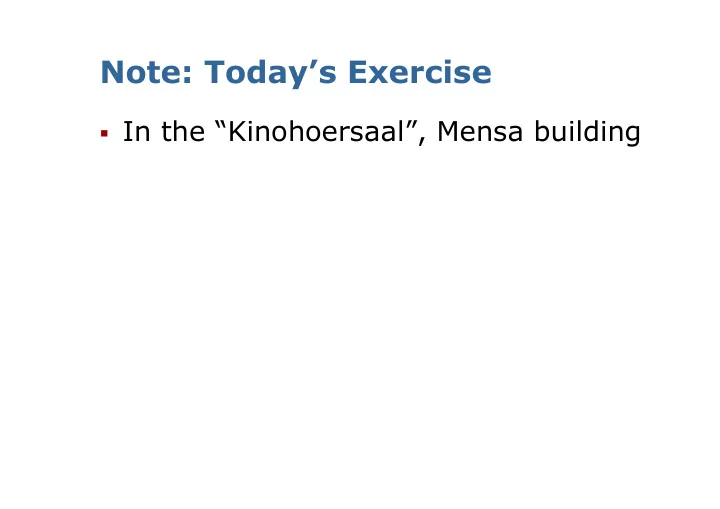

Note: Today’s Exercise § In the “Kinohoersaal”, Mensa building
Introduction to Mobile Robotics Techniques for 3D Mapping Wolfram Burgard, Cyrill Stachniss, Maren Bennewitz, Kai Arras 2
Point Clouds § Pro: § No discretization of data § Mapped area not limited § Contra: § Unbounded memory usage § No direct representation of free or unknown space 3
3D Voxel Grids § Pro: § Volumetric representation § Constant access time § Probabilistic update § Contra: § Memory requirement: Complete map is allocated in memory § Extent of the map has to be known/guessed 4
2.5D Maps: “Height Maps” Average over all scan points that fall into a cell § Pro: § Memory efficient § Constant time access § Contra: § Non-probabilistic § No distinction between free and unknown space 5
Elevation Maps § 2D grid that stores an estimated height (elevation) for each cell § Note: Uncertainty increases with measured distance Fig. 3. Variance of a height measurements depending on the distance of the beam. 6
Elevation Maps § 2D grid that stores an estimated height (elevation) for each cell § Note: Uncertainty increases with measured distance § Kalman update to estimate the elevation 7
Elevation Maps § Pro: § 2.5D representation (vs. full 3D grid) § Constant time access § Probabilistic estimate about the height § Contra: § No vertical objects § Only one level is represented 8
Typical Elevation Map 9
Extended Elevation Maps § Identify § Cells that correspond to vertical structures § Cells that contain gaps § Check whether the variance of the height of all data points is large for a cell § If so, check whether the corresponding point set contains a gap exceeding the height of the robot (“gap cell”) 1 0
Example: Extended Elevation Map Cells with vertical § objects (red) Data points above a big § vertical gap (blue) Cells seen from above § (yellow) → use gap cells to determine traversability extended elevation map 11
Types of Terrain Maps Point cloud Standard elevation map Extended elevation map 13
Types of Terrain Maps Point cloud Standard elevation map + Planning with underpasses possible (cells with vertical gaps) − No paths passing under and crossing over bridges possible (only one level per grid cell) Extended elevation map 14
Types of Terrain Maps Point cloud Standard elevation map Extended elevation map Multi-level surface map 15
MLS Map Representation Each 2D cell stores various patches consisting of: § The height mean µ § The height variance σ § The depth value d Z Note: § A patch can have no depth (flat objects, e.g., floor) § A cell can have one or many patches (vertical gap cells, e.g., bridges) X 16
From Point Clouds to MLS Maps § Determine the cell for each 3D point gap size § Compute height intervals § Classify into vertical Y (>10cm) and horizontal intervals X § Apply Kalman update to estimate the height based on all data points for the horizontal intervals § Take the mean and variance of the highest measurement for the vertical intervals 17
Results The robot can pass under and go over the § Map size: 299 by 147 m bridge § Cell resolution: 10 cm § Number of data points: 45,000,000 20
Experiments with a Car § Task: Reach a parking spot on the upper level 21
MLS Map of the Parking Garage 22
MLS Maps § Pro: § Can represent multiple surfaces per cell § Contra: § No representation of unknown § No volumetric representation but a discretization in the vertical dimension § Localization in MLS maps is not straightforward
Octree-based Representation § Tree-based data structure § Recursive subdivision of the space into octants § Volumes allocated as needed § “Smart 3D grid” 24
Octrees § Pro: § Full 3D model § Probabilistic § Inherently multi-resolution § Memory efficient § Contra: § Implementation can be tricky (memory, update, map files, …) 25
OctoMap Framework § Based on octrees § Probabilistic, volumetric representation of occupancy including unknown § Supports multi-resolution map queries § Memory efficient § Compact map files § Open source implementation as C++ library available at http://octomap.sf.net 26
Probabilistic Map Update § Occupancy modeled as recursive binary Bayes filter [Moravec ’85] § Efficient update using log-odds notation 27
Probabilistic Map Update § Clamping policy ensures updatability [Yguel ‘07] § Multi-resolution queries using 1.28 m 0.08 m 0.64 m 28
Lossless Map Compression § Lossless pruning of nodes with identical children § Can lead to high compression ratios [Kraetzschmar ‘04] 29
Video: Office Building Freiburg, building 079 30
Video: Large Outdoor Areas Freiburg computer science campus (292 x 167 x 28 m ³ , 20 cm resolution) 31
6D Localization with a Humanoid Goal: Accurate pose tracking while walking and climbing stairs 33
Video: Humanoid Localization 34
Summary § Different 3D map representations exist § Octomap is currently a popular tool § Main advantages: Full 3D model, probabilistic representation, inherently multi-resolution, memory efficient
Recommend
More recommend